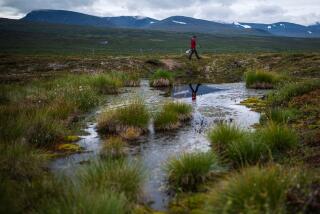Warming Arctic trying to keep its cool, study finds
- Share via
An international team of scientists Thursday reported that rising temperatures were steadily transforming the Arctic -- warming millions of square miles of permafrost, promoting lush greenery on previously arid tundras and steadily shrinking the annual sea ice.
Yet the researchers also found new patterns of cooling ocean currents and prevailing winds that suggested the Arctic, long considered a bellwether of global warming, may be reverting in some ways to more normal conditions not seen since the 1970s.
Taken together, researchers said, these findings may be evidence of the region struggling to keep its balance as rising temperatures slowly overturn the long-established order of seasonal variations.
“This is a region that is fighting back,” said lead author Jacqueline A. Richter-Menge, a civil engineer at the Army Corps of Engineers’ Cold Regions Research and Engineering Laboratory in Hanover, N.H. “There are things that showed signs of going back to norms, trying to right themselves under very dire circumstances.”
For a year, 20 researchers in seven countries reviewed the condition of the atmosphere, ocean, sea ice and land at the top of the world. They summarized their findings in “State of the Arctic,” a report released Thursday by the National Oceanic and Atmospheric Administration.
On average, global temperatures have been steadily warming for decades -- 2005 was the warmest year since record-keeping began in 1880 -- but the Arctic appears to be warming twice as fast as the rest of the world. Local weather variations at Earth’s upper latitudes, however, create a seesaw of annual hot spots and cold sinks above the Arctic Circle that, combined with incomplete data, can easily disguise longer regional climate trends.
By pulling together data from many countries and scientific sources, the researchers sought to determine more conclusively how the climate throughout the Arctic behaved from 2000 through the winter of 2006.
“Arctic temperatures were above their average -- at least 1 degree centigrade above average over the entire Arctic over the entire year. This is a unique situation,” said coauthor James Overland at the NOAA’s Pacific Marine Environmental Laboratory in Seattle. Last year, the Arctic sea ice shrank to record levels every month but May, continuing a trend that started in 2000, the researchers reported. Moreover, the permanent ice cap has been thinning. Summer melting also began earlier every year and was more extensive.
Glaciers everywhere receded. For the last five years, rivers flowing into the Arctic Ocean have been swollen 3% to 9% higher than average with fresh meltwater, stream gauges showed. That, in turn, has made the seawater less salty, which affects ocean currents.
Permafrost throughout the Alaskan Arctic steadily warmed, records showed. Last year, soil temperatures in the interior of Alaska were among the warmest of the last 70 years, the researchers reported.
In response, vegetation in the tundras increased by 10% over the last 20 years, satellite measurements showed.
Shrubs rooted more readily above the Arctic Circle in Alaska and Siberia.
The new ground cover provided shelter for some creatures but made it harder for others, such as reindeer and caribou herds, to move through their grazing grounds.
More to Read
Sign up for Essential California
The most important California stories and recommendations in your inbox every morning.
You may occasionally receive promotional content from the Los Angeles Times.










